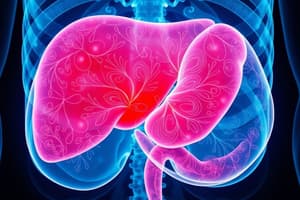Podcast
Questions and Answers
Which test is used to detect cholecystitis?
Which test is used to detect cholecystitis?
- Fluid wave test (correct)
- LUQ pain test
- CVA tenderness test
- Hepatomegaly test
What does a palpable fluid wave into the suprapatellar recess confirm?
What does a palpable fluid wave into the suprapatellar recess confirm?
- Cholecystitis
- Knee fractures
- Ascites
- Major effusion (correct)
What defines where to elicit for kidney tenderness?
What defines where to elicit for kidney tenderness?
- Costovertebral angle (CVA) (correct)
- Hepatomegaly
- LUQ pain
- Cholecystitis
What does a palpable liver edge below the ribs indicate in chronic liver disease?
What does a palpable liver edge below the ribs indicate in chronic liver disease?
When is the span of liver dullness increased?
When is the span of liver dullness increased?
What does a positive fluid wave test indicate?
What does a positive fluid wave test indicate?
What is the costovertebral angle (CVA) formed by?
What is the costovertebral angle (CVA) formed by?
What does a palpable returning fluid wave into the suprapatellar recess confirm?
What does a palpable returning fluid wave into the suprapatellar recess confirm?
What does a previously utilized test to detect an impulse transmitted through ascitic fluid from one flank to the opposite side test for?
What does a previously utilized test to detect an impulse transmitted through ascitic fluid from one flank to the opposite side test for?
What does a palpable liver edge below the ribs reliably indicate?
What does a palpable liver edge below the ribs reliably indicate?
What does a decreased span of liver dullness indicate?
What does a decreased span of liver dullness indicate?
What is the costovertebral angle (CVA) used to check for?
What is the costovertebral angle (CVA) used to check for?
Flashcards are hidden until you start studying
Study Notes
Abdominal Examination
- Murphy's sign is used to detect cholecystitis.
- A palpable fluid wave into the suprapatellar recess confirms ascites.
- Kidney tenderness is typically elicited at the costovertebral angle (CVA).
- A palpable liver edge below the ribs in chronic liver disease indicates hepatomegaly.
- The span of liver dullness is increased in hepatomegaly.
- A positive fluid wave test indicates ascites.
- The costovertebral angle (CVA) is formed by the 12th rib and the vertebral column.
- A palpable returning fluid wave into the suprapatellar recess confirms ascites.
- Shifting dullness is a previously utilized test to detect an impulse transmitted through ascitic fluid from one flank to the opposite side.
- A palpable liver edge below the ribs reliably indicates hepatomegaly.
- A decreased span of liver dullness indicates liver atrophy.
- The costovertebral angle (CVA) is used to check for kidney tenderness.
Studying That Suits You
Use AI to generate personalized quizzes and flashcards to suit your learning preferences.




